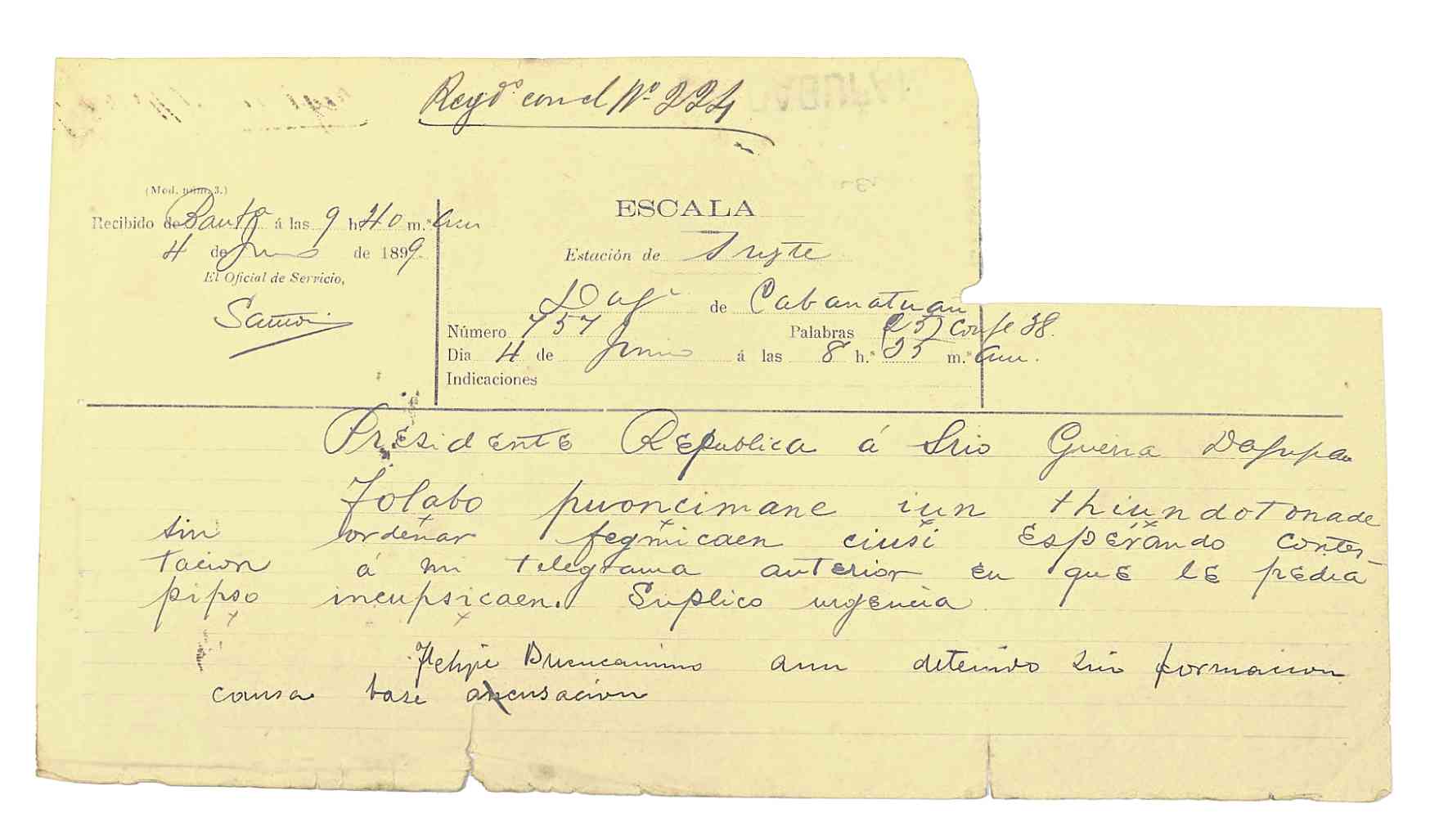
Controversy continues to swirl over a telegram sold at auction last week for P3.2 million.
That may seem like a lot of money for a yellowed piece of paper with a missing corner, but this is no ordinary telegram—it was heralded as “The Extremely Historically Important Hen. Luna Telegram from Emilio Aguinaldo summoning him to his death.”
Everyone who has seen the blockbuster film “Heneral Luna” is curious to know the mastermind behind Luna’s assassination, and this telegram may very well be the smoking gun historians have been looking for.
Or is it?
A noisy minority, including partisans of Emilio Aguinaldo, claim the telegram is fake, not knowing that a clerk or telegraph operator in Luna’s Dagupan office copied and numbered it in a log book.
The log is part of the mass of documents known as the “Philippine Insurgent Records” now preserved in The National Library of the Philippines.
Not one, but three
Decades ago I went quickly through the log that covers May 14 to June 24, 1899 and did not find any “deadly” telegram message in it.
Historian Jim Richardson recently checked the microfilm copy, made from a master in the United States Library of Congress that had the foresight to index and photograph the entire archive before the original documents were repatriated to Manila, like the Balangiga Bells, as a gift.
He found not one but three telegrams addressed to the Secretary of War, sent from the President’s Headquarters in Cabanatuan on June 4, 1899, the day before Luna’s death.
These are numbered 211, 218 and 224. All contain the same message as the “deadly” telegram sold at auction last week: “Folabo puoncimane iun thiundotonade sin ordenar fegmicaen ciusi Esperando contestacion a mi telegrama anterior en que le pedia piso incupsicaen Suplico urgencia.”
The message in Spanish, with some words scrambled in a simple code, can be decoded by switching the vowels and some consonants into: “Felipe Buencamino aun detenido sin ordenar formacion causa. Esperando contestacion a mi telegrama anterior en que le pedia base acusacion. Suplico urgencia.”
No reply
Decoded words rendered in italics above match Antonio Luna’s scrawl at the bottom of the message. Luna did not draft a
reply as stated in the auction catalog, he decoded the message upon receipt of the telegram.
Translated from the original Spanish, the message reads:
“Felipe Buencamino is detained without ordering the formation of the case. I await your reply to my previous telegram where I request the basis for your accusation. Beseech urgency.”
The above decoding does not match the message supplied in the auction catalog, allegedly dictated by Aguinaldo in his pajamas, who was disheveled from a sleepless night.
The auction house also claims the telegram was sent four times in succession to ensure that Luna met his appointment with death:
“Paging for an important meeting, therefore you are ordered to come here immediately. Waiting for a reply to my previous telegram about urgent matters to discuss. It is really an emergency.”
The auction catalog’s translation of Luna’s “reply” at the bottom reads: “Felipe Buencamino not yet detained based on my accusation.”
Glaring
Unfortunately, these glaring discrepancies generate more questions than answers. If there were indeed four messages sent, but only three in the log book, where is the fourth?
Why don’t the messages in the auction notes and the actual coded message match? Did Luna really receive a “deadly telegram”? Was the deadly telegram a ruse?
If so, was it one of the papers fished out of Luna’s pockets after the assassination, given to Buencamino, and destroyed to cover the killers’ tracks?
If it exists, will we ever find this deadly telegram or a copy in some telegraph operator’s log?
Luna temper
Until validated by later primary source research, can we presume that Luna received the urgent request for him to substantiate his accusation of treason against Felipe Buencamino, who could not be detained much longer without substantiated charges?
Since Luna received the same message thrice, his short fuse leads him to forego reply by telegram and he rides off to Cabanatuan in a huff to lay his case against Buencamino, in person, before the President.
Upon arrival, Luna is told the President is away, and his famous temper flares up when he finds Buencamino in the President’s headquarters and not behind bars.
His anger heightens when he sees members of Aguinaldo’s Kawit bodyguard, whom he had disarmed and punished for insubordination, likewise feeling at home in Cabanatuan.
Luna throws a fit, shouts some choice expletives, and threatens to return with his troops to exact punishment upon them.
Hearing this the soldiers attack, leaving Luna and his aide Paco Roman dead.
Later, the murderers claim self-defense and go scot-free. Nobody asks why a company of soldiers could not subdue and disarm two men.
Luna’s 30 wounds suggest extreme anger and rage on the part of his killers. That half the wounds Luna received would have been fatal to a lesser man suggests he was hacked, stabbed, and shot even when dead. Or maybe the overkill was to make sure he was dead?
Due diligence
The good news is that Richardson did find a telegram inviting Luna to a meeting in the Insurgent Records.
The bad news is that the date is obscured by the folds and tears during microfilm reproduction.
When the original is located and validated, the elusive “deadly telegram” will stand up to be recognized.
Thorough historical research of important lots should be part of due diligence in an auction catalog.
While the “deadly” telegram angle can be dismissed as auction hype, the effect of its urgency, it having been sent thrice, in the end proved lethal to Luna, leaving us to speculate on who really wanted him dead and why.
E-mail the author at aocampo@ateneo.edu.